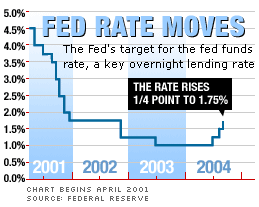NEW YORK (CNN/Money) -
Last week's strong October employment report may have crushed any chance of a December pause for the Fed.

It's practically a sure thing that the Federal Reserve will raise its most closely watched interest rate another quarter percentage point, to 2 percent, when the central bank's policy-makers meet Wednesday, marking the fourth straight increase this year.
But debate has been raging for several months on what the Fed -- which has pledged to raise rates at a "measured" pace from their super low levels -- would do in December.
Before Friday, investors were betting on roughly a 50 percent chance of a December rate hike, but by Monday that had jumped to about an 80 percent chance, according to fed funds futures contracts traded in Chicago.
And many economists and Fed watchers actually agreed with the shift of sentiment.
"Two weeks ago traders thought there was no chance," said Sung Won Sohn, chief economic officer of Wells Fargo Bank. "If you had asked me Thursday, I would have said less than a 50 percent chance (of a December hike), at best I would have said a 50-50 chance. Now it looks pretty likely."
Sohn said the strong employment report would just convince Fed policy-makers they were right in saying recently that the economy is strong enough to withstand more rate hikes.
In light of that, a December rate hike would be the Fed "basically saying, 'We told you so'," said Sohn.
Even some of those who had been expecting a December hike still admit the Fed will probably pause at some point, though when is hard to say.
"I do think a pause is coming along at some point," said Lyle Gramley, a former Fed governor and now a consulting economist with Schwab Washington Research. "My guess has been all along that a pause was more likely in the first meeting of next year than in December. The October employment report strengthens that view."
The growing anticipation of a December hike means that if the Fed still wants the opportunity to pause in December, it's probably going to have to start signaling that at this week's meeting. That's why what the Fed says Wednesday will be closely watched for those seeking clues about the December meeting.
If the Fed includes language stressing the strength of the economy, it could be more evidence of another rate hike in December. If the statement includes any warnings about the recovery, it could put the question of a December hike back in play.
Janet Yellen, president of the Federal Reserve Bank of San Francisco and a voting member of the Fed's policy-making arm, gave a speech late in October in which she said, "I wouldn't say we're completely out of the woods just yet. Indeed there are some issues that have the potential to be troublesome going forward."
Any other language indicating Fed uncertainty about the strength of the U.S. recovery on Wednesday will convince investors that the Fed is going to pause sooner rather than later.
The policy-setting committee, however, is not expected to make many changes to the statement accompanying its rate decision, apart from acknowledging the improvement in the labor market in more confident terms than it has been using.
A sure thing?
Not quite, a Wall Street watcher said. "I don't think it's a sure thing they'll tighten in December, even if it is now more likely," said Mark Vitner, senior economist at Wachovia Securities.
Oil prices need to fall further, perhaps below $45 a barrel, for the Fed to raise short-term rates again in December. "It needs to get closer to $40 before they feel comfortable. If it's $45 or above, I think it (a December rate hike) is 50-50, at best," he said.
Gramley, Vitner and others point out there'll be a slew of fresh economic numbers for the Fed to consider before the Dec. 14 meeting, including the November employment report, which will be out Dec. 3.
One reason the stronger-than-expected October payroll number got so much attention is that a stronger labor market can lead to higher wages -- and inflation -- which the Fed is bound by law to try to avoid.
On the other hand, if October's strong payroll number turns out to be a blip, that could point to another "soft-patch" in the economic recovery, which could lead the Fed to hold steady in December -- and perhaps the early part of next year.
But even some critics of the Fed's policy of measured interest rate hikes believe the October report cast the die in favor of a December rate hike.
Car sales may also play a role as the numbers declined in October from incentive-stoked levels of the previous month, which suggests that overall retail sales for October will also be lower.
"I still have my problems with the economy and how strong it's doing," said Robert Brusca of FAO Economics.
"But even if you have a weak number next month, even if you get zero growth, you'd be averaging about 150,000 new jobs a month (for the last six months.) So the Fed would need to see something less than zero to change its mind."

-- Reuters contributed to the story
|